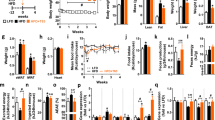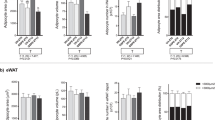Abstract
Background/Objective:
Consumption of green tea has become increasingly popular, particularly because of claimed reduction in body weight. We recently reported that animals with pharmacological inhibition (by candoxatril) or genetic absence of the endopeptidase neprilysin (NEP) develop an obese phenotype. We now investigated the effect of green tea extract (in drinking water) on body weight and body composition and the mediating role of NEP.
Subjects/Methods:
To elucidate the role of NEP in mediating the beneficial effects of green tea extract, ‘Berlin fat mice’ or NEP-deficient mice and their age- and gender-matched wild-type controls received the extract in two different doses (300 or 600 mg kg−1 body weight per day) in the drinking water.
Results:
In ‘Berlin fat mice’, 51 days of green tea treatment did not only prevent fat accumulation (control: day 0: 30.5% fat, day 51: 33.1%; NS) but also reduced significant body fat (green tea: day 0: 27.8%, day 51: 20.9%, P<0.01) and body weight below the initial levels. Green tea reduced food intake. This was paralleled by a selective increase in peripheral (in kidney 17%, in intestine 92%), but not central NEP expression and activity, leading to downregulation of orexigens (like galanin and neuropeptide Y (NPY)) known to be physiological substrates of NEP. Consequently, in NEP-knockout mice, green tea extract failed to reduce body fat/weight.
Conclusions:
Our data generate experimental proof for the assumed effects of green tea on body weight and the key role for NEP in such process, and thus open a new avenue for the treatment of obesity.
This is a preview of subscription content, access via your institution
Access options
Subscribe to this journal
Receive 12 print issues and online access
$259.00 per year
only $21.58 per issue
Buy this article
- Purchase on Springer Link
- Instant access to full article PDF
Prices may be subject to local taxes which are calculated during checkout



Similar content being viewed by others
References
Cheng TO . Will green tea be even better than black tea to increase coronary flow velocity reserve? Am J Cardiol 2004; 94: 1223.
Yang CS, Wang H . Mechanistic issues concerning cancer prevention by tea catechins. Mol Nutr Food Res 2011; 55: 819–831.
Yuan JM, Sun C, Butler LM . Tea and cancer prevention: epidemiological studies. Pharmacol Res 2011; 64: 123–135.
Dulloo AG, Duret C, Rohrer D, Girardier L, Mensi N, Fathi M et al. Efficacy of a green tea extract rich in catechin polyphenols and caffeine in increasing 24-h energy expenditure and fat oxidation in humans. Am J Clin Nutr 1999; 70: 1040–1045.
Roth J, Qiang X, Marban SL, Redelt H, Lowell BC . The obesity pandemic: where have we been and where are we going? Obesity Res 2004; 12: 88–101.
NHS - The Information Centre Statistics on Obesity, Physical Activity and Diet: England, January 2008. In: NHS - The Information Centre (ed) NHS - The Information Centre. The Information Centre: London, 2008, p 222.
Bell CG, Walley AJ, Froguel P . The genetics of human obesity. Nat. Rev. Genet. 2005; 6: 221–234.
Becker M, Siems WE, Kluge R, Gembardt F, Schultheiss HP, Schirner M et al. New function for an old enzyme: NEP deficient mice develop late-onset obesity. PloS One 2010; 5: e12793.
Pankow K, Schwiebs A, Becker M, Siems WE, Krause G, Walther T . Structural substrate conditions required for neutral endopeptidase-mediated natriuretic peptide degradation. J Mol Biol 2009; 393: 496–503.
Scholzen TE, Luger TA . Neutral endopeptidase and angiotensin-converting enzyme – key enzymes terminating the action of neuroendocrine mediators. Exp Dermatol 2004; 13: 22–26.
Walther T, Albrecht D, Becker M, Schubert M, Kouznetsova E, Wiesner B et al. Improved learning and memory in aged mice deficient in amyloid beta-degrading neutral endopeptidase. PloS One 2009; 4: e4590.
Melzig MF, Janka M . Enhancement of neutral endopeptidase activity in SK-N-SH cells by green tea extract. Phytomedicine 2003; 10: 494–498.
Klaus S, Pultz S, Thone-Reineke C, Wolfram S . Epigallocatechin gallate attenuates diet-induced obesity in mice by decreasing energy absorption and increasing fat oxidation. Int J Obesity 2005; 29: 615–623.
Shimotoyodome A, Haramizu S, Inaba M, Murase T, Tokimitsu I . Exercise and green tea extract stimulate fat oxidation and prevent obesity in mice. Med Sci Sports Exerc 2005; 37: 1884–1892.
Lu B, Gerard NP, Kolakowski Jr LF, Bozza M, Zurakowski D, Finco O et al. Neutral endopeptidase modulation of septic shock. J Exp Med 1995; 181: 2271–2275.
Wagener A, Schmitt AO, Aksu S, Schlote W, Neuschl C, Brockmann GA . Genetic, sex, and diet effects on body weight and obesity in the Berlin Fat Mouse Inbred lines. Physiol Genomics 2006; 27: 264–270.
Netsch MI, Gutmann H, Luescher S, Brill S, Schmidlin CB, Kreuter MH et al. Inhibitory activity of a green tea extract and some of its constituents on multidrug resistance-associated protein 2 functionality. Planta Med 2005; 71: 135–141.
Faber F, Gembardt F, Sun X, Mizutani S, Siems WE, Walther T . Lack of angiotensin II conversion to angiotensin III increases water but not alcohol consumption in aminopeptidase A-deficient mice. Regul Pept 2006; 136: 130–137.
Ayoub S, Melzig MF . Induction of neutral endopeptidase (NEP) activity of SK-N-SH cells by natural compounds from green tea. J Pharm Pharmacol 2006; 58: 495–501.
Schafer S, Linz W, Vollert H, Biemer-Daub G, Rutten H, Bleich M et al. The vasopeptidase inhibitor AVE7688 ameliorates type 2 diabetic nephropathy. Diabetologia 2004; 47: 98–103.
Friedrich M, Petzke KJ, Raederstorff D, Wolfram S, Klaus S . Acute effects of epigallocatechin gallate from green tea on oxidation and tissue incorporation of dietary lipids in mice fed a high-fat diet. Int J Obesity 2012; 36: 735–743.
Medeiros Mdos S, Turner AJ . Metabolism and functions of neuropeptide Y. Neurochem Res 1996; 21: 1125–1132.
Adams AC, Clapham JC, Wynick D, Speakman JR . Feeding behaviour in galanin knockout mice supports a role of galanin in fat intake and preference. J Neuroendocrinol 2008; 20: 199–206.
Ishihara A, Kanatani A, Mashiko S, Tanaka T, Hidaka M, Gomori A et al. A neuropeptide Y Y5 antagonist selectively ameliorates body weight gain and associated parameters in diet-induced obese mice. Proc Natl Acad Sci USA 2006; 103: 7154–7158.
Erondu N, Gantz I, Musser B, Suryawanshi S, Mallick M, Addy C et al. Neuropeptide Y5 receptor antagonism does not induce clinically meaningful weight loss in overweight and obese adults. Cell Metab 2006; 4: 275–282.
Acknowledgements
The research has been supported by grants from the Deutsche Forschungsgemeinschaft (DFG; WA1441/18-1, SI483/8-1; WA1441/18-2, SI483/8-2). The authors thank Frutarom for providing the green tea extract free of charge. Furthermore, the intense discussions with Professor Stephen Atkin (Hull York Medical School) and the technical support by Esther-Pia Jansen, Bettina Kahlich, and Stephanie Führl are greatly appreciated.
Author information
Authors and Affiliations
Corresponding author
Ethics declarations
Competing interests
The authors declare no conflict of interest.
Rights and permissions
About this article
Cite this article
Muenzner, M., Tappenbeck, N., Gembardt, F. et al. Green tea reduces body fat via upregulation of neprilysin. Int J Obes 40, 1850–1855 (2016). https://doi.org/10.1038/ijo.2016.172
Received:
Revised:
Accepted:
Published:
Issue Date:
DOI: https://doi.org/10.1038/ijo.2016.172
This article is cited by
-
Regulation of Neprilysin Activity and Cognitive Functions in Rats After Prenatal Hypoxia
Neurochemical Research (2019)



